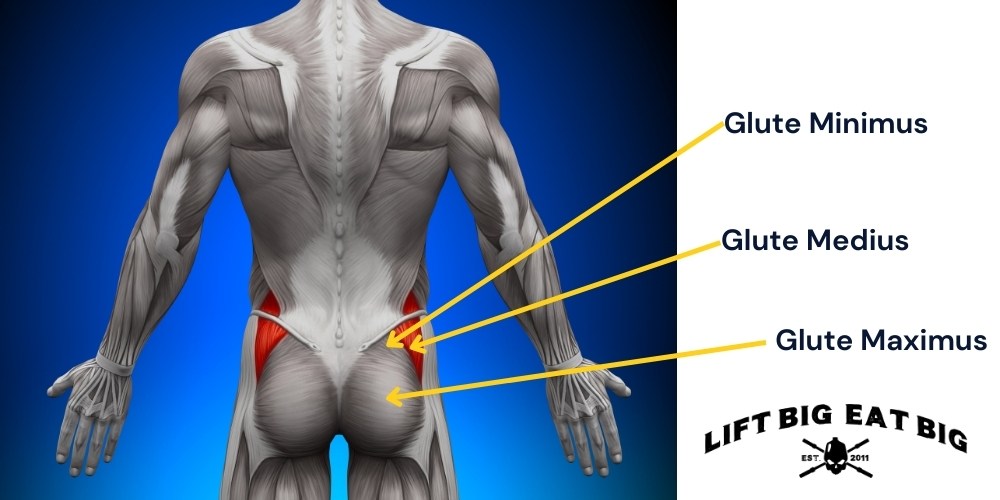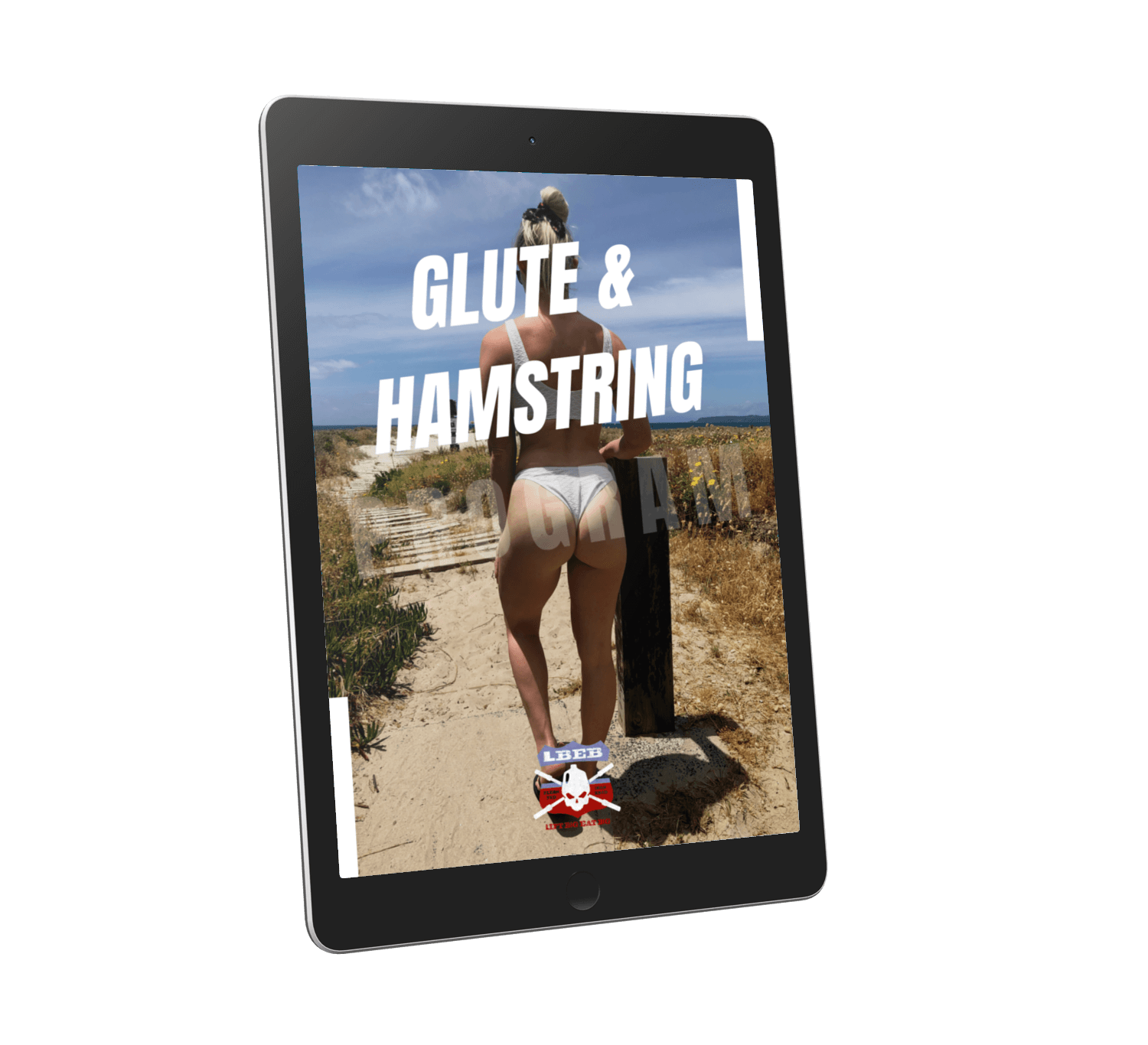Are you tired of doing countless squats and lunges but still not seeing the lower glute gains you're after? Fear not! I’m giving you the most effective lower glute exercises that will have you feeling the burn and seeing the results you crave. So, grab your gym gear and get ready to sculpt your dream booty!
But before you do that, it’s essential to understand basic glute anatomy and what the lower glutes really are.
Table of Contents
Glute Anatomy
There are three main glute muscles:

The gluteus medius and minimus are smaller glute muscles that abduct the hip (think of 80s Jane Fonda lying lateral leg raise) and medially rotates the leg (turn the leg inward). The gluteus maximus is the large, powerful muscle of the butt that extends the leg and assists in lateral rotation (turning the leg outward).
The muscle responsible for the lower glutes is the gluteus maximus which also makes up the upper glutes.
What Is The Underbutt?
The underbutt is known as the glute-ham tie-in or butt crease. It’s the portion where your glute and leg muscles come together. Interestingly, we can preferentially target the lower glutes even though the same muscle contributes to creating the upper glute shelf.
For example, the upper and lower glutes were activated to different degrees among the exercises tested [1]. To target the lower glutes or glute-ham tie-in, you need exercises that take the glutes through stretch, which also target the upper hamstrings.
Here’s my list of the best lower glute exercises!
12 Best Lower Glute Underbutt Exercises
Romanian Deadlift
The Romanian deadlift is a far better lower glute builder than the deadlift. The deadlift doesn’t maximally stretch the glutes and doesn’t stress hip extension to the same extent as the RDL.
You can make small movement modifications, like bending the knees more when descending to place less stretch on the hamstrings and more stress on the glutes. You can also take a wider stance to hit the glutes harder [2]. Here’s how to do it:
Single Leg Romanian Deadlift
The single-leg deadlift nails both the glute maximus and medius as you need to stabilize on one leg. Compared to the traditional deadlift, the single-leg deadlift elicits greater concentric glute medius muscle activation and eccentric gluteus maximus and medius activation [4].
It was speculated that the torso being close to parallel with the floor might place greater stress on the hip than the deadlift. Here’s how to do it:
Front Foot Elevated Split Squat
I’m a huge fan of elevating the front foot for split stance exercises. A typical split squat stops when your knee touches the floor. There is no way to go further to increase the range of motion.
But by elevating the front foot, you can get deeper placing a more significant stretch on the glutes and upper hamstrings. Both are vital for developing the underbutt. Here’s how to do it:
Reverse Lunge
For your lower glutes, the reverse lunge trumps the forward lunge because of the shin angle and the ease of loading your backside versus your quads. A slight forward lean also helps stretch the glutes throughout the movement, promoting muscle growth. Here’s how to do it:
Front Foot Elevated Reverse Lunge
The front foot elevated reverse lunge is similar to the split squat but is more dynamic. Because of the increased need for balance, holding a post with the opposite arm to the working leg can make this exercise easier. Further, you’ll be able to load it heavier with better balance. Here’s how to do it:
Bulgarian Split Squat
Because your back leg is elevated during the Bulgarian split squat, you place more weight on your front leg forcing it to work more.
In contrast, the lunge and split squat have the back leg on the ground, which help significantly with the exercise. Keep a vertical shin to target the lower glutes, reducing knee stress [5]. Therefore, increasing the stress on your backside. Here’s how to Bulgarian split squat:
Front Foot Elevated Bulgarian Split Squat
This is the most brutal version of the front foot elevated exercises. Because your back leg is also elevated, the depth you can reach is only limited by your hip flexors and glutes. Be careful doing these the first time, as going too deep too quickly can lead to injury. Here’s how to do it:
High Box Step Up
Could the step-up be the ultimate glute exercise? Scientific research mixed with elite-level anecdotal evidence may suggest it is. A systematic review compiling all of the relevant glute muscle activation research found the step-up light up the glutes the most [3].
Unfortunately, only one study has investigated the step-up in this regard. However, legendary throws coach from the Soviet Union Anatoly Bondarchuk replaced the squat with the step-up as, based on his own research, it was safer, and no athlete found themselves in a full squat position.
The ideal position for the box height has your knee above your hips to target the lower glutes. This is where the glutes and high hamstrings are maximally stretched. Interestingly, the Bulgarian Weightlifting team dropped all back squatting in favor of the step-up.
It was reported many lifters had stopped squatting and hit personal best snatch and clean & jerks. The world record holder at the time Leonid Taranenko who clean & jerked 586 pounds, only performed the step-up as his heavy leg training for four years leading up to this.
His best step-up was 396 pounds for 3 reps with each leg which is insane. What matters to you, however, is the Soviet coaches observed the lifters who used the step-up instead of the squat developed more complete muscularity than someone who not just lifted heavy weights but also sprinted and jumped.
So, if you're after giant glutes like a sprinter, use the step-up! Here’s how to do it:
45° Back Extension
In my experience, you must perform the back extension a certain way to get the most from the glutes. That is, pushing your hips through the pad instead of raising your shoulders. You'll feel a massive difference with your glutes burning compared to raising the shoulders.
Compared to the reverse hyper, we see 23% greater gluteus maximus activation [6]. However, the severe limitation of this study was the same load being used for both exercises. The reverse hyper is typically loaded much heavier than the back extension, potentially leading to greater glute muscle activation since the load is vital for force contribution from the glutes.
Here’s how to do the 45° back extension to target the glutes:
Hyper Deads
The hyper dead is my favorite back extension variation. It’s the strictest hip extension exercise, maximally overloading the glutes and hamstrings. However, you need a 45° back extension. While you can use a 90° back extension, I’ve found the range of motion is too short. Here’s how to do it:
Quadruped Hip Extension
The quadruped hip extension is the exercise you’ll often see in Pump or group fitness classes. But they never load it heavy enough to have a great effect. Instead, you need to use a Smith machine or reverse hyper to load this effectively.
Research has indicated that the quadruped hip extension elicits significantly lower glute muscle activity than other glute exercises [1]. Here’s how to do it:
Single Leg Hip Thrust
The single-leg hip thrust is another exercise demonstrating high lower glute activation [1]. It can be more challenging to load, but I’ve found using sandbags the most comfortable. Here’s how to do it:
Best Lower Glute Workout
Exercise | Set/Rep | Load |
|---|---|---|
A1) Single Leg Hip Thrust | 3 x 15 | 8 RPE |
B1) Front Foot Elevated Reverse Lunge | 3 x 8/leg | 8 RPE |
C1) Hyper Dead | 2 x 6 | 8 RPE |
D1) Quadruped Hip Extension | 3 x 12/leg | 9 RPE |
Summary
Use these lower glute exercises to target the glute-ham tie-in and develop a firmer butt. As long as you feel your glutes working during these exercises, you’re on the right track. Also, you’ll get more glute training volume when you squat on your quad-dominant training days.
References
1. Selkowitz, D. M., Beneck, G. J., & Powers, C. M. (2016). Comparison of electromyographic activity of the superior and inferior portions of the gluteus maximus muscle during common therapeutic exercises. journal of orthopaedic & sports physical therapy, 46(9), 794-799.
2. Koderi, K. L., Tan, K., Azzfar, M. S., Abd Malek, N. F., Mohamad, N. I., & Nadzalan, A. M. (2020, April). The effects of stance width on muscle activation and performance during Romanian deadlift exercise. In Journal of Physics: Conference Series (Vol. 1529, No. 2, p. 022026). IOP Publishing.
3. Neto, W. K., Soares, E. G., Vieira, T. L., Aguiar, R., Chola, T. A., de Lima Sampaio, V., & Gama, E. F. (2020). Gluteus maximus activation during common strength and hypertrophy exercises: A systematic review. Journal of sports science & medicine, 19(1), 195.
4. Diamant, W., Geisler, S., Havers, T., & Knicker, A. (2021). Comparison of EMG Activity between Single-Leg Deadlift and Conventional Bilateral Deadlift in Trained Amateur Athletes-An Empirical Analysis. International journal of exercise science, 14(1), 187.
5. Mackey, E. R., & Riemann, B. L. (2021). Biomechanical Differences Between the Bulgarian Split-Squat and Back Squat. International Journal of Exercise Science, 14(1), 533.
6. Lawrence, M. A., Chin, A., & Swanson, B. T. (2019). Biomechanical Comparison of the Reverse Hyperextension Machine and the Hyperextension Exercise. The Journal of Strength & Conditioning Research, 33(8), 2053-2056.


